While running as fast as I could sustain for 26 miles at the Napa Valley Marathon one week ago, I had plenty of time to ponder “the why” of the endeavor.
I even said out loud, “Why?!” around Mile 22 as toe-curling charley horse cramps preyed on my arch and calf, causing my left foot to spasm and lower leg to stiffen. My pace slowed to a discouraging 9 minutes per mile in some of those final stiff-legged miles, but I willed myself to keep running instead of becoming one of the defeated-looking walkers I kept passing.
Cramps from running, by the way, are not primarily caused by salt deficiency or dehydration, contrary to popular belief. My electrolyte intake and fluids were fine. Rather, the cramps represented a kind of neuromuscular panic attack—a sign that I had pushed myself past the point that my body had adapted to handle. In other words, the severe cramps signaled I was undertrained for the combination of intensity and duration I was striving to achieve. It’s true, I hadn’t trained quite as much or as well as I could have to achieve my goal. But at least the cramps signaled I was giving everything I could to the effort.
I certainly wasn’t running this race—my first serious attempt at a road marathon in a decade—”for fun.” If it were for fun, then I would have settled in to a relaxed pace, allowed myself some walking breaks, and chatted socially with those around me, thereby treating it like the early miles of an ultra.
Instead, I focused and ran silently with those around me, as dead serious as if we all were taking an important exam without a break for 3.5 hours. Frequently, I tucked behind one of the runners to copy the rhythm of his or her stride. This was one of the few things I enjoyed about the marathon: the wordless bond among the cluster of runners whose presence helped carry me along, and the opportunity to study their style and running form as we traversed miles, each runner developing into a character study in my mind.
Based on my training, and on two half marathons I raced since New Year’s—both of which I finished just under 1:45—I set a realistic goal to break 3:40, with a stretch goal to break 3:35.
I had to face the reality that averaging a pace in the 8:10 – 8:20 range, to finish around 3:35 – 3:40, was aspirational but achievable. My ego takes a hit just typing those numbers, because they reflect how much slower I am than in my road-running prime as a thirtysomething. Once upon a time, I could break 1:30 at the half marathon (around a 6:50/mile average pace), and I PR’ed at the Napa Valley Marathon in 2009 with a time of 3:05:53, an average pace of 7:05/mile. Now I struggle to run more than a minute per mile slower than that PR pace for the marathon, and anything under 8-minute miles feels extra fast.
As the Napa marathon unfolded down the paved Silverado Trail, bisecting green vineyards dappled yellow with blooming mustard, I hit my goal pace in the first half, then slowed in the second half due to fatigue and a headwind. Overall I averaged an 8:29 pace. The coach in me objectively concludes I ran smart but was undertrained—a little too light on the training volume, a little too heavy on the body weight. During the past two months, I prioritized other things going on in my life, and overindulged on some comfort food and drink due to life stress and travel, so be it.
When I crossed the finish line in 3:42, I felt profoundly relieved and mostly satisfied, feeling just a twinge of disappointment at missing sub-3:40.
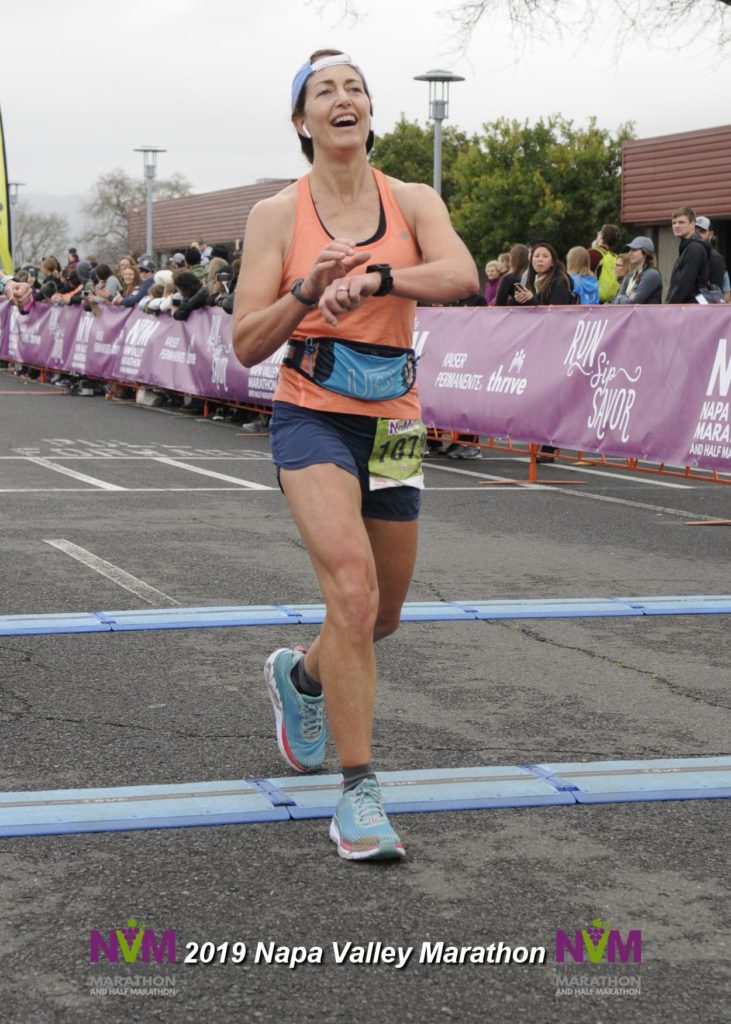
Then I hopped around in pain as the cramps rebelled in full force. I literally had to lie down to keep from falling over, and a runner friend, Mitch Gunderson, kindly rubbed my feet and uncurled my toes to help calm the muscular insurgency.
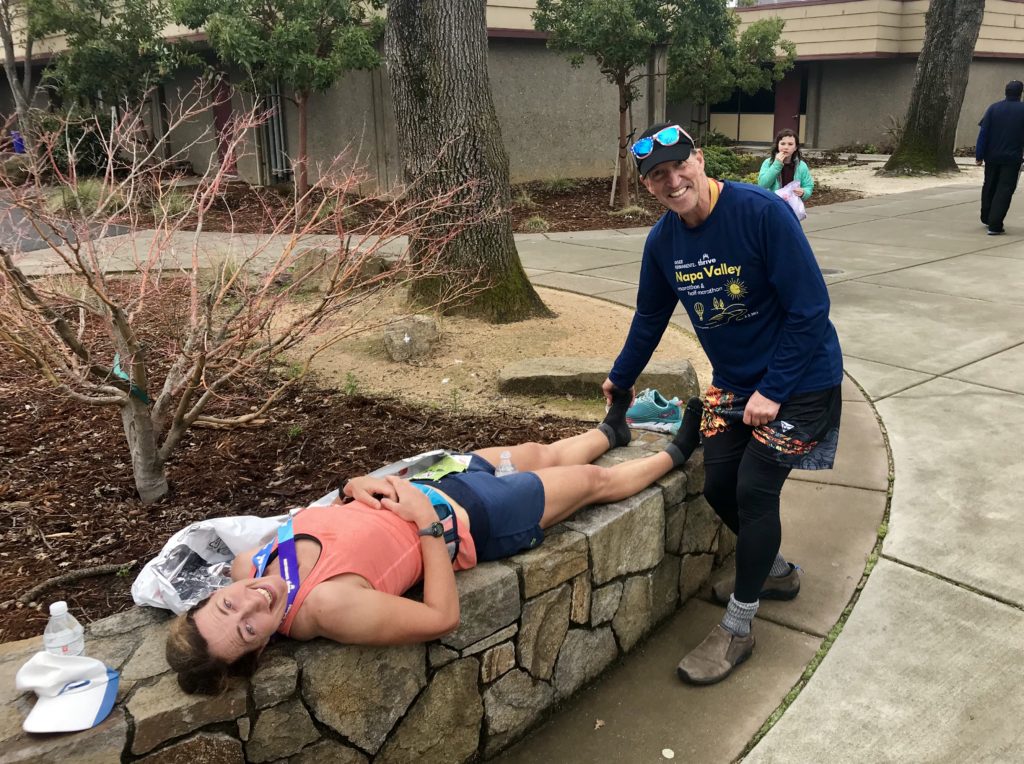
Overall, was it a worthwhile experience? Yes, but I wouldn’t say I liked it. To borrow a punchline from my forthcoming column in UltraRunning magazine, I feel about it the way my husband feels about his colonoscopy: glad to have done it and achieved a decent result, but grateful it’s over and not looking forward to the next one.
Honestly, the best, happiest parts of race day were the beginning and the end, and not just because I felt the anticipation of starting and the relief of finishing. It’s also because I got to hang out with two of my clients and friends, Kim Nichelini and Kimberly Perricelli. Focusing on their performance and their feelings somewhat liberated me from thinking about my own. It felt exciting to imagine what they were going through with their marathons, and satisfying to witness their success.

I didn’t have to run this marathon; I could have driven up to spectate. So why do it? I concluded these are the main reasons:
Because it’s hard and I’m not so good at it anymore.
The farther away I got from road marathoning and that PR set in 2009, the more intimidating and daunting it felt to try it again. And because it felt hard and scary to push myself to run at a higher intensity level for 26 miles and to see the clock reveal how much I’ve slowed down over the years, it loomed as an important personal challenge, in many ways harder to face than an ultra-distance trail race.
I recognized that I have changed and slowed as a runner over the past several years not just from age-related decline in oxygen-processing capacity, but also from extra-slow miles spent trail running, especially in the high altitude of Colorado’s mountains. I believe my focus on tortoise-like trail running fundamentally altered my stride sense of pace. That meant I’d have to work extra hard to earn back some of my leg turnover and speed, along with the stamina to keep running relentless flat terrain instead of fluctuating my pace according to a spiky hill profile.
This year’s marathon challenge developed into more than a test to run fast; it became a dare to see if I could let go of—or at least make peace with—the psychological baggage that my ego carries. It also challenged me to be process-oriented rather than outcome-oriented, which I coach my clients to be, by focusing on doing the best I can and enjoying the week-by-week process of training rather than obsessing over the outcome of race day.
I wanted to be brave and go through the process and try it again, even if the outcome might disappoint, because if I didn’t give it a good try, then I knew I’d feel as if I’d wimped out and left behind unfinished business.
Because it makes me feel sentimental and reflect on life.
My first baby is about to turn 21, and my second is about to graduate from high school. We just sold our house of 19 years and are building another one. Milestones like these make one reflect on life’s big narrative arc.
For me, the Napa Valley Marathon stands as an event almost as significant as births, deaths, marriages and dream-home moves, because this event got me running 25 years ago and changed my life for good. I was a graduate student two months shy of turning 25, not in very good shape and never into playing sports, when I went to the 1994 Napa marathon to watch two friends run it. I knew virtually nothing about running and wanted to attend for the sake of a post-race picnic, not to watch a bunch of runners, but witnessing all those regular-looking people running in spite of suffering after Mile 20 completely captivated and inspired me.
I tried running the next day—my first real 3-mile run ever, the first Monday of March 1994—and got hooked and became determined to run the marathon the following year.
When I think back to running my first marathon at Napa in 1995, I recall the excitement and wonder unique to being a beginner. I didn’t realize at the time that I looked like a dorky newb—ill-fitting hat rising up over bushy ponytail, oversized cotton shirt (from the 1994 Bay to Breakers) tucked into shorts, chubby thighs rubbing and chafing. I was in the best shape of my life and felt extraordinary for being one of the marathoners pinning on a bib. I was utterly elated by running the whole thing and squeaking under 4 hours.
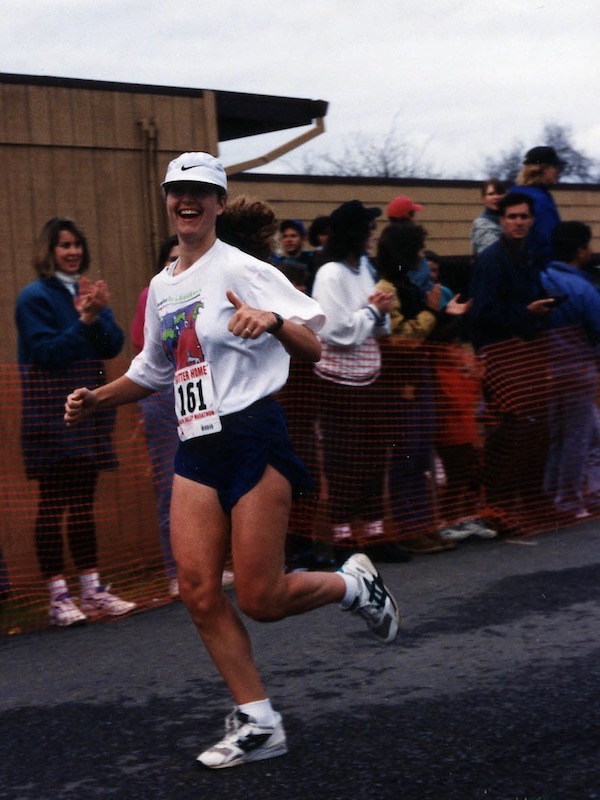
I went back to the Napa Valley Marathon this year to reflect on the quarter-century journey, and to try to connect more with that first year’s enthusiasm and innocence void of self-criticism. I hoped to rekindle my 25-year-old self’s celebratory joy, and to let go of trying to be the faster 39-year-old who set a personal best there in 2009. Alas, on this front I didn’t fully succeed, but at least I tried.
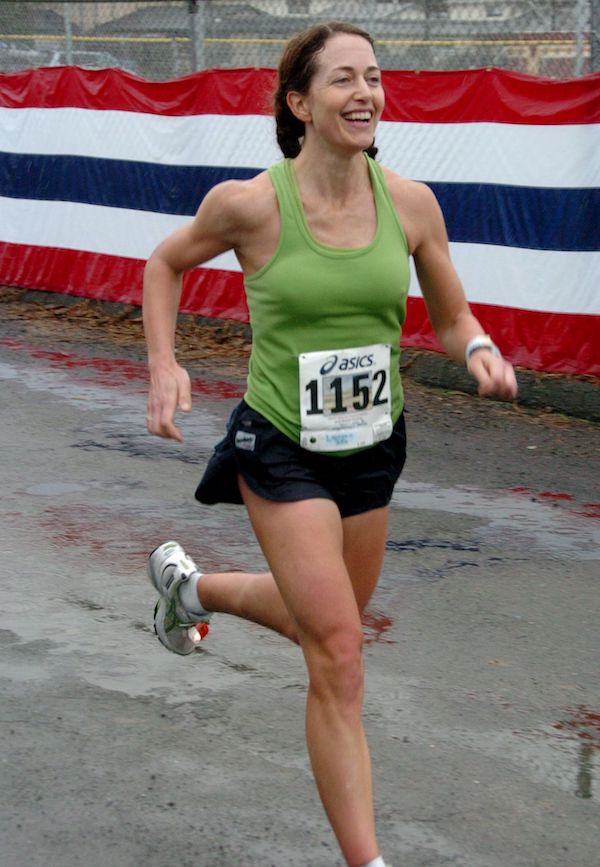
However, being at the starting line of the Napa Valley Marathon again, and reliving those earlier marathons, genuinely made me feel emotional and profoundly grateful for how becoming a runner transformed my life and gave me so much personal growth and happiness over 25 years.
Because I want to be a better runner.
Training for a road marathon with a goal time made me a better runner by sharpening fitness and improving form. Doing deliberate, more challenging speedwork and steady long runs with fast finishes—plus racing the two half marathons earlier this season for practice—boosted my performance more than typical trail training does. The lesson, I think, is to maintain elements of this training, and to keep working on form and cadence, as much as possible.
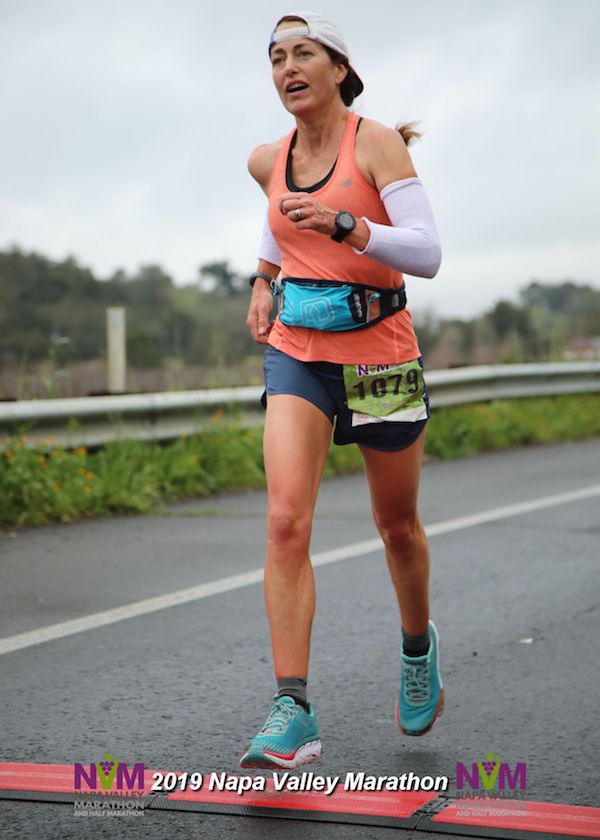
Two days ago, my body felt recovered enough from the marathon to head out on a 20-mile trail run with nearly 3000 feet of vertical gain. Thanks to the mega workout of the marathon five days earlier, my legs felt stronger and faster—and my mind, more motivated—while trail running than they had in months. It’s as if the depletion and recovery of the road marathon super-charged my desire and ability to train for upcoming ultras.
Thankfully, I qualified to enter the lottery for the Boston Marathon (see qualifying standards), and by enough of a margin for my age group (13 minutes) that I have a good shot at a spot. I’d like to run Boston one more time in 2020 (having done it twice before, in 2000 and 2009), this time truly for fun, soaking up the sights and reveling in the experience like a tourist.
Let me end with a story I find inspiring and gratifying—my client Kim Nichelini’s mini race report—because her example shows that you get out of training what you put into it. Whereas I’d give myself a B grade or about 85 percent for the effort and dedication I put into my marathon training, Kim went “all in” to achieve her goal at Napa. She transformed from an ambivalent mid-packer who took longer than 4 hours to finish a marathon, to a committed athlete realizing her potential and qualifying for Boston.
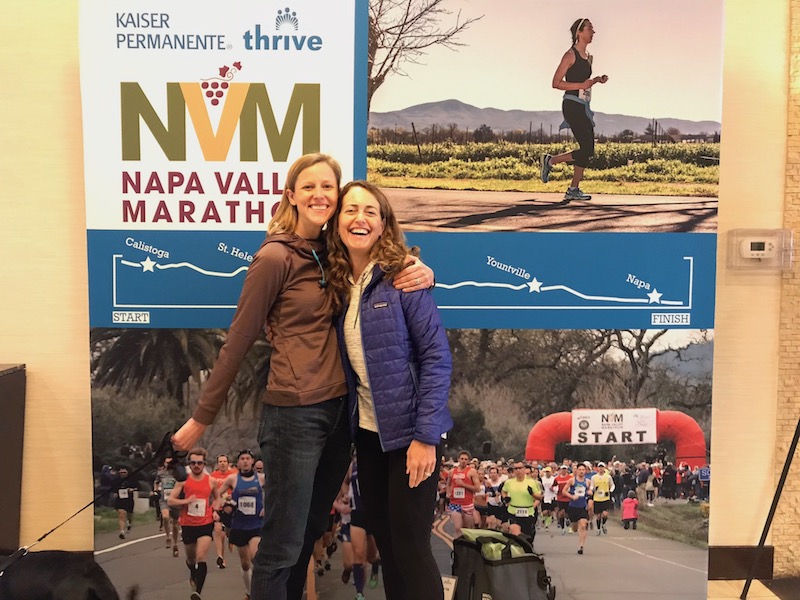
Kim, who’s 34 and works full time as a pediatric dentist, wrote the following:
“Seven months ago when I reached out to Sarah, I was in a running rut, feeling unmotivated and slow and ready to give up the sport for good. I had harbored a secret dream for almost 10 years of someday qualifying for the Boston Marathon. Last summer I was running 10+ minutes/mile and not recognizing what I was doing wrong in my training attempts. My most recent marathon time had been 4:40+ with a LOT of walking and self-berating in the final 8 miles.
“On our initial phone consult, I was barely able to share my ultimate goal with Sarah because it seemed so far out of reach. But Sarah was encouraging, confident and kind, and said that based on my previous PRs she believed a BQ was (eventually) possible. She set out a basic training plan for me with several phases (build base, build volume, peak training, taper). In those first few weeks I was embarrassed to upload my times: 10:30-11:15 minutes/mile for my long runs, walk breaks, aborted attempts to complete the training as planned. I used Sarah’s book often for strength training and also nutrition and gear advice. After about four weeks of lots of effort for some very slow runs, Sarah suggested I get some basic blood tests done. Sure enough, I was very anemic. Within 2 weeks of iron supplementation and 6 weeks into Sarah’s plans, I was feeling MUCH stronger and able to run a 2:02 half marathon (9:16 average pace) feeling peppy!
“Empowered by my progress, I started leaning into her plans striving to complete each one exactly as directed, and I improved dramatically. I was able to run a 3:46 marathon [at the California International Marathon in Sacramento last December] after 3.5 months of training with Sarah at an 8:40 average pace, feeling strong and proud with perfectly even splits and even sprinted across the finish line. She encouraged me to go for a Boston-qualifying time (3:35 for my age group) just three months later, and then coached me to a half PR of 1:43, and at my full marathon in Napa, a PR and BQ of 3:34 (8:10 average pace).
“Looking back at my training notes from six months ago, I barely recognize myself; I struggled, made excuses and considered quitting often. Today I feel confident that when I start a run, I’ll finish what I set out to do, and I perceive headwinds, hill repeats, treadmill inclines and long weekday tempo runs in the dark as opportunities to get stronger instead of reasons to quit. During these months I worked full time, bought and moved to a new home, acquired a puppy, and dealt with weeks of bad air after fires and drenching storms, so we had to do some juggling of the schedule. Sarah is supportive of life balance (she gets it!) but does not accept excuses and recommended a very balanced plan. I’ll remember this achievement that seemed so out of reach forever, and I know I wouldn’t be the confident runner I am today without Sarah’s expertise, guidance and support.”
Now THAT makes me happy!

Well done, Sarah! I hope one day soon enough I will be brave to take on this kind of challenge, again, just because. Or any race, for that matter. Congratulations.
First of all, you seem to look younger with each passing year! As a 52 year old mom of 3 boys (21,18,15), I am always motivated by your posts and have gained great wisdom from your book. My first marathon in 2011 by chance, qualified me for Boston and though I moved to trails after 3 marathons, my 1st was my PR. I do sometimes lament my loss of (relative) speed, but traded it in for longer ultras with no regrets. It’s all out there for the taking and grab the motivation when it comes, regardless of distance or time. It may be time to retain your coaching services after Kims great report😀 Best of luck with your training.
Yes, yes, yes! Thank you for sharing so much of your experience and feelings. Your race report speaks so much to me, and I am sure many other runners as we progress, regress, and progress in our running lives; it is reassuring to know that there are other runners, especially runners as accomplished as you, who have similar growing pains and joys. Happy running, and congratulations on your achievement! Good work!